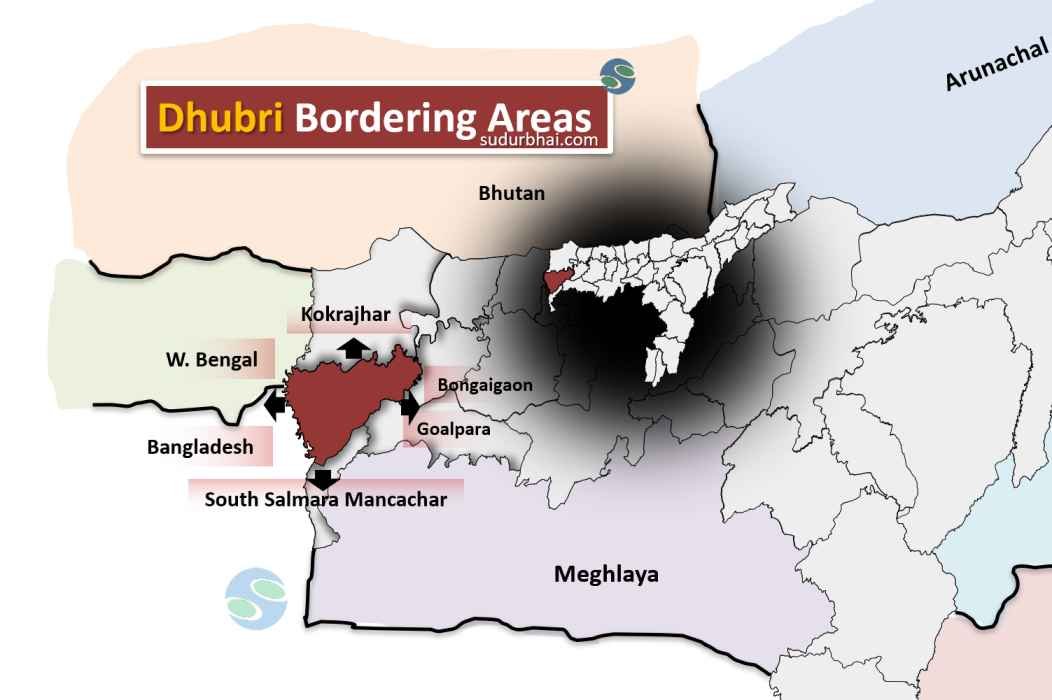Dhubri District
District overview of Dhubri District
- Location: Western Assam, India.
- Nickname: Known as the “Land of Rivers” due to its geographical location along the Brahmaputra River.
- Key Features: Rich cultural heritage and historical significance.

History of Dhubri District
Ancient References: Dhubri is mentioned in ancient texts such as the Kalika Purana and Yogini Purana as part of the Kamarupa kingdom, ruled by dynasties like the Varmans, Mlechhas, and Palas (350–1100 CE).
Etymology: The name “Dhubri” is believed to derive from a local legend involving Netai Dhubuni, a woman who washed clothes on the Brahmaputra’s banks, as recounted by the merchant Chand Sadagar (3rd century CE).
Medieval Era: In the late 15th century, the Bengal Sultanate briefly controlled Dhubri, transforming it from a fishing village to a trading post along the Brahmaputra.
Religious Heritage: The Panbari Mosque, built between 1493–1519 CE by Hussain Shah, Governor of Bengal, is one of Assam’s oldest mosques and a significant Islamic site.
Mughal-Ahom Conflicts: The area saw major conflicts between the Mughals and the Ahoms in the 17th century, notably the Battle of Saraighat (1671) and the Battle of Itakhuli (1682), after which the Ahoms regained control.
Sikh Influence: Guru Nanak visited Dhubri in the early 16th century, and later, Guru Tegh Bahadur’s visit led to the founding of the Gurdwara Sri Guru Tegh Bahadur Sahib. Dhubri became a Sikh pilgrimage center, especially after the arrival of Sikh soldiers in the early 19th century.
Colonial Period: The British established Goalpara district in 1876, with Dhubri as one of its three subdivisions. The district headquarters shifted from Goalpara to Dhubri in 1879.
Cultural Melting Pot: Under British rule, Dhubri developed as an administrative and commercial hub, attracting diverse communities and fostering a unique blend of languages, religions, and art.
Post-Independence: After the 1947 partition, Dhubri lost some prominence but remained a significant border district, with the Brahmaputra River marking the end of its journey in India here.
Formation as District: On July 1, 1983, Dhubri was carved out as a separate district from Goalpara, becoming an administrative center in western Assam.
Geography of Dhubri District
- Area: 2,838 square kilometers.
- Boundaries:
- North: Kokrajhar district..
- South: South-Salmara Mancachar district.
- East: Bongaigaon district , Goalpara district.
- West: West Bengal , Bangladesh

Dhubri bordering Districts
- Topography: Flat plains, crisscrossed by rivers like the Brahmaputra, Gandhi, and Gangadhar.
- Climate: Humid subtropical with heavy rainfall during the monsoon season.
- Average Annual Rainfall: Around 2,309 mm.
- Monsoon: The majority of rainfall occurs from May to October, supporting agriculture.
Socio-Economy of Dhubri District
- Economy: Primarily agrarian.
- Major Crops: Rice, jute, mustard, potatoes, and fruits.
- Jute production has been historically significant.
- Livestock Farming: Includes cattle, goats, and poultry.
- Bilasipara –An important river port, and presence of cigarette factory.
- Golokganj – Noted for Aluminium industry
- Trade and Commerce: Dhubri is an important commercial hub with a river port facilitating trade, especially in jute.
- Challenges: Despite agricultural potential, Dhubri faces challenges like poverty and lack of infrastructure development.
Transport in Dhubri District
- Roadways: Well-connected by National Highway 27, linking to other towns and cities in Assam.
- Railways: The nearest station is Dhubri Railway Station on the New Cooch Behar-Golokganj line.
- Airways: Rupsi Airport, about 15 km from Dhubri, connects to Guwahati and Kolkata.
Demographics of Dhubri District
- Population Statistics
Total Population: 1,949,258
Male Population: 997,848 (51.19%)
Female Population: 951,410 (48.81%)
Population Growth Rate (2001-2011): 24.44%
Population Density: 896 persons per square kilometer (Second highest)
- Sex Ratio
Overall Sex Ratio: 953 females per 1000 males
Child Sex Ratio (0-6 years): 968 females per 1000 males
- Literacy Rate
Average Literacy Rate: 58.34% (Lowest)
Male Literacy Rate: 63.10%
Female Literacy Rate: 53.33%
- Child Population
Total Children (0-6 years): 368,262 (18.89% of total population)
Male Children (0-6 years): 187,092
Female Children (0-6 years): 181,170
- Rural and Urban Distribution
Rural Population: Approximately 89.55%
Urban Population: Approximately 10.45%
- Religious Composition
- As per the census:
Islam: 73.49%
Hinduism: 26.07%
Others or not stated: 0.44%
- As per the census:
Administrative Setup of Dhubri District
- Established: In 1983, carved out from Goalpara district.
- Sub-Divisions: Dhubri (Sadar) and Bilasipara.
- Revenue Circles: Eight revenue circles.
- Development Blocks: Thirteen development blocks.
- Legislative Assembly Constituencies: Five constituencies: Dhubri, Gauripur, Golakganj, Bilasipara West, and Bilasipara East.
- Headquarters: Dhubri town.
Tourist Places in Dhubri
- Gurdwara Sri Guru Teg Bahadur Sahib (oldest sikh Temple of Assam): A significant religious site for Sikhs near Dhubri.Guru Nanakdev visited the area in the early 16th century
- Chandardinga Hill – According to folklore, Chanda Sadagar ( a wealthy merchant from Bengal) worshipped Lord Shiva on this hill to seek protection from Manasa Devi, the serpent goddess. And this played a key role in his eventual acceptance of Manasa Devi’s divine power.
- Malanga Dham Temple: A popular Hindu pilgrimage site with beautiful architecture.
- Brahmaputra Riverfront: Scenic views offering leisure activities.
- Chakrasila Wildlife Sanctuary Declared a wildlife sanctuary in 1994, Chakrasila is dedicated to conserving endangered species and exotic animals. Animals include the leopard cat, porcupine, flying squirrel, civet cat, Indian owl, cobra, turtle etc.
- Panchpeer Dargah This holy place for Muslims is the resting place of five Sufi Saints who came with Raja Ram Singh when he invaded Assam
- Historical Sites: Connected to the Koch Rajbongshi kings.
Languages Spoken in Dhubri District
- Assamese: 37.97%
- Bengali: 18.98%
- Rajbongshi: 5.65%
- Hindi: 2.15%
- Bhatia: 1.21%
- Other Assamese: 31.12% (This includes various dialects and forms of Assamese)
- Other Bengali: 0.91%
Let us know any further suggestions ,we at sudurbhai.com will be happy to hear from you in our comment section below !
